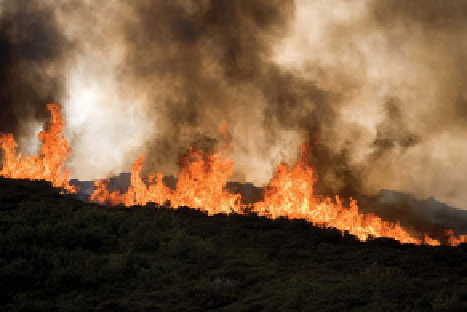Geoscience Reference
In-Depth Information
3.6.1.3. Health Effects
Water vapor has no direct harmful effects on humans.
Liquid water in aerosol particles indirectly causes health
problems when pollutant gases dissolve in it or other
solid particles attach to it. Small particles can be
inhaled, causing health problems.
Table 3.6.
Sources and sinks of atmospheric carbon
dioxide
Sources
Sinks
Bacterial fermentation
Bacterial anaerobic
respiration
Bacterial aerobic respiration
Plant, animal, fungus, and
protozoa aerobic
respiration
Evaporation from oceans
Atmospheric chemical
reaction
Vo l canic outgassing
Biomass burning
Fossil fuel and biofuel
combustion
Cement production
Oxygen-producing
photosynthesis
Sulfur-producing
photosynthesis
Bacterial anaerobic
respiration
Dissolution in surface
water
Deposition to sea ice,
snow, soil, vegetation,
and structures
Chemical weathering of
carbonate rocks
Photolysis in upper
atmosphere
3.6.2. Carbon Dioxide
Carbon dioxide
[CO
2
(g)] is a colorless, odorless, nat-
ural greenhouse gas that is currently also responsi-
ble for almost half of the higher global temperatures
due to global warming. Although it does not directly
impact health at typical mixing ratios found in out-
door air, its anthropogenic emissions over cities pro-
duce
carbon dioxide domes
that increase local tem-
peratures and water vapor, both of which increase the
concentrations of other pollutants that damage health
(Jacobson, 2010a) (Section 12.5.6). CO
2
(g) also acidi-
fies rain slightly because it is a weak acid that dissolves
in rainwater (Section 10.2.1), but such acidity does
not cause environmental damage. CO
2
(g) also plays a
role in stratospheric ozone depletion because its global
warming in the troposphere enhances global cooling of
the stratosphere, and stratospheric cooling damages the
ozone layer (Section 12.5.7). Ambient mixing ratios
of carbon dioxide are not regulated in any country.
CO
2
(g) emission controls are the subject of an ongoing
effort by the international community to reduce global
warming.
Like water vapor, carbon dioxide is a greenhouse gas.
Unlike water vapor, CO
2
(g) has few chemical loss pro-
cesses in the gas phase. Its main chemical loss is pho-
tolysis to CO(g) in the upper stratosphere and meso-
sphere, but the CO
2
(g) lifetime against loss by this
process alone is about 200 years. Its data-constrained
e
-folding lifetime, from emission to removal, due to all
loss processes, ranges from 30 to 50 years. An impor-
tant removal mechanism of CO
2
(g) is its dissolution
in surface water. Dissolution occurs by the reversible
3.6.2.1. Sources and Sinks
Table 3.6 lists the major sources and sinks of CO
2
(g).
Carbon dioxide is produced during several bacterial
metabolism processes, including fermentation (Reac-
tion 2.3) and denitrification (Reactions 2.7 and 2.8), and
aerobic respiration in plant and animal cells (Reaction
2.12). Other sources of CO
2
(g) consist of evaporation
from the oceans, chemical oxidation of carbon monox-
ide and organic gases, volcanic outgassing, fossil fuel
combustion, biofuel combustion, and biomass burning
(Figure 3.10). The single largest source of CO
2
(g) is
bacterial decomposition of dead organic matter. Indoor
sources of CO
2
(g) include human exhalation and com-
bustion of gas, kerosene, fuel oil, wood, and coal.
CO
2
(g) is removed from the air by oxygenic photo-
synthesis (Reaction 2.10), dissolution in surface water
(e.g., ocean, lake, river, stream water); deposition to sea
ice, snow, soil, vegetation, and structures; and chemical
weathering.
Figure 3.10.
Vegetation fire. Emissions from the fire
include gases (e.g., carbon dioxide, carbon monoxide,
nitric oxide, organics) and aerosol particles (e.g., soot,
organic matter).
C
Eliasgomez/Dreamstime.com.





Search WWH ::

Custom Search